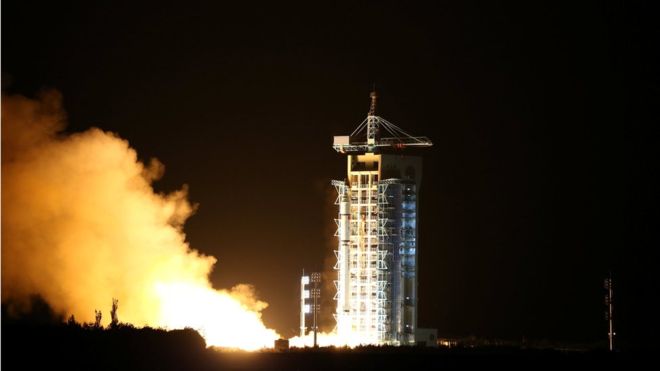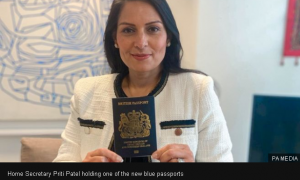导读:据国内媒体报道,近日中国成功发射了全球首颗量子通讯卫星“墨子号”。

It was carried on a rocket which blasted off from the Jiuquan Satellite Launch Centre in China’s north west early on Tuesday.
本周二早些时候,在甘肃酒泉卫星发射中心,“墨子号”由一架火箭搭载成功发射升空。
The satellite is named after the ancient Chinese scientist and philosopher Micius.
这枚量子卫星以中国古代先贤科学家、哲学家墨子为名。
The project tests a technology that could one day offer digital communication that is "hack-proof".
这个项目测试了一项技术,而这项技术在未来将会提供一种可以“防黑客”的数字通信系统。
But even if it succeeds, it is a long way off that goal, and there is some mind-bending physics to get past first.
但是即使这次卫星发射成功了,要达到那个目标也要有很长的路要走,而且还必须要先解决一些烧脑壳的物理问题。
How does it work?
它是如何运作的?
The satellite will create pairs of so-called entangled photons - tiny sub-atomic particles of light whose properties are dependent on each other - beaming one half of each pair down to base stations in China and Austria.
这颗卫星将会产生许多对所谓的“量子纠缠”,量子纠缠即一对光的亚原子粒子,它们的特性属性取决于对方。每一对量子纠缠的一半都会被传输到中国和奥地利的基站中。
This special kind of laser has several curious properties, one of which is known as "the observer effect" - its quantum state cannot be observed without changing it.
这种特殊的激光有几个奇怪的性质,其中一个性质被称为“观察者效应”--量子态无法在不被改变的情况下被观察到。
So, if the satellite were to encode an encryption key in that quantum state, any interception would be obvious. It would also change the key, making it useless.
因此,如果这颗卫星要在量子态中加密秘钥的话,任何拦截都是显而易见无意义的。密码将会被改变,使得其毫无用处。
If it works, it will solve the central problem of encrypted communications - how to distribute keys without interception - promising hack-proof communications. The encrypted message itself can be transmitted normally after the key exchange.
如果确实可行的话,将解决加密通信的核心问题--如何在不被拦截的情况下分发秘钥--从而实现不受黑客窃听的通信。在交换秘钥之后,加密信息本身可以正常地传输。
Has it been done before?
以前有过先例吗?
Not from space, making this launch experimental. But fibre-optic quantum key distribution networks already exist in Europe, the US and China.
以前从未有国家往太空中发射过量子卫星,因此此次中国的发射具有实验性质。但是欧洲、美国和中国已经存在有光纤量子秘钥分发网络了。
The signals weaken over distance though, which this project is hoping to minimise by sending the signals mostly through space, keeping attenuation to a minimum despite the distances involved.
尽管随着距离的变长,信号的强度会减弱,但是这个项目希望藉由主要通过太空传输信号的办法来将信号减弱剪至最小,从而在长距离传输的情况下把信号衰减控制在最小。
But aside from the tricky physics, there is also the difficult matter of firing tiny sub-atomic particles at precise targets on the ground, across vast distances, while travelling incredibly fast through space. There are good reasons this is the first attempt.
但是除开棘手的物理问题之外,这里还有一个问题--如何向地表精确目标发射微小的亚原子粒子,因为不仅发射器和接收器的距离非常远,而且卫星还以难以置信的高速在太空中移动着。因此完全有理由说此次发射是全球第一次类似的尝试。
Why China?
为什么是中国?
It has the money. China has allocated vast amounts of money for basic scientific research in its latest five-year development plan. It’s also willing to take big risks on some as-yet unproven technologies.
因为中国有钱。在最新的五年发展计划期间,中国下拨了大笔资金用于基础科学研究。同时,中国也甘冒极大风险来从事那些尚未被证明的技术的研究。
But while China is leading the project, officially titled Quantum Experiments at Space Scale (QUESS), Austria is also involved.
但是尽管是中国领导了该项目(项目官方名称是“空间尺度量子实验”(QUESS)),但是奥地利也参与到了其中。
The scientist who first proposed the idea to the European Space Agency (ESA), without success, in 2001, is University of Vienna physicist Anton Zeilinger. He is now working on the latest project under the man whose PhD he once supervised, Pan Jianwei of the Chinese Academy of Sciences.
奥地利维也纳大学物理学界安东·蔡林格是第一位提出这个想法的科学家,他在2001年的时候向欧洲空间局(ESA)提出了这个想法,但是却没有成功。蔡林格目前正在这个项目里工作,而这个项目的带头人正是他曾经的博士学生--中科院院士潘建伟。







